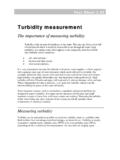Transcription of Introduction to Jackson Design Method: JSP and a little JSD
1 Introduction to Jackson Design Method: JSP and a little JSD Nicholas Ourusoff Placed into the public domain by Nicholas Ourusoff, 2003 Table of Contents Introduction Preface Part I: Jackson Structured Design (JSP) 1 Program Structure Introductory remarks; An example: Printing a multiplication table; Structure diagrams, program and data structure; Exercises 2 Jackson Structure Diagrams Jackson Structure Diagrams; Examples; Program structure based on data structure; Elementary versus generalized components; Exercises 3 JSP: Basic Design Method and the Single Read-ahead rule Basic Design Method; Single Read-ahead Rule; Pascal file processing: non-text files; Pascal file processing: textfiles 4 Multiple Data Structures Processing hierarchical record sets; Getting it wrong--A Cautionary tale; Getting it right; Group-id rule; Collating; Exercises 5 Error processing Introduction ; Error versus invalid data.
2 Error processing Design objectives; Valid and invalid data; Exercises 6 Recognition Problems and Backtracking Multiple read-ahead rule; Backtracking; Backtracking (within iteration); quit in iteration; Backtracking in iteration; Exercises 7 Structure Clashes and Program Inversion Structure Clashes; Program Inversion; Implementation of inversion; Significance of program inversion; Exercises 8 Optimization Attitude towards optimization; Types of optimization 9 Summary Programming languages and compilers; Simple program and serial data streams Part II: Jackson System Development (JSD) 10 Jackson System development (JSD): An Overview A Simple program: Student loan system; Modeling phase; Network phase; Implementation phase 2 Introduction There are two reasons for writing this book.
3 First, I believe that JSDOOP--coupling the object-based modeling of JSD with object-oriented implementation--is a promising method for information system development. Second, I believe the clear and seminal thinking of Michael Jackson about program and information system Design methodology deserves more attention than it has received in the United States; and his contributions have often been 1. The promise of JSDOOP In the Spring of 1991, I experimented with implementing a JSD specification into an object-oriented programming (OOP) language (Smalltalk).
4 JSD seemed to me then to be object-based in the sense that it begins with a model of the real world in terms of a set of entities (objects), their actions (behavior), and constraints. In fact, as I found later, JSD is object-based in the most fundamental sense--the structure of a program or information system is based on the structure of the problem. This is the single most basic principle throughout Michael Jackson 's writing. As John Cameron puts it: " Jackson System Development (JSD) and Object-Oriented Design (OOD) have one major--arguably central--principle in common; namely that the key to software quality lies in the structuring of the solution to a problem in such a way as to reflect the structure of the problem itself.
5 There should be a simple and demonstrable correspondence between a (real world) component of the problem and a (software) component of the solution. The two methods also use similar concepts to describe the problem domain (or 'real world'). It is considered to consist of identifiable objects ('entities' in JSD) and operations that are either performed or suffered by these objects ('actions' in JSD}."2 My investigations showed that indeed a JSD entity mapped into a Smalltalk object, with JSD actions mapping into methods and an entity's state vector into an object's instance variables.)
6 There is overwhelming evidence that JSD specifications can be directly implemented in OOP even without proving the concept by implementing JSD specifications: (1) When we examine what an entity is in JSD, we find that it is consistent with an OOP object. A JSD entity has the following properties: 1 As an example, in one of the articles surveying OOD in CACM, Oct 1991, JSD is said to be an acronym for " Jackson Structured Design ". In fact, JSD stands for " Jackson System Development".
7 More importantly, anyone familiar with Jackson 's methodology knows that Jackson argues forcefully against structured Design methodology which is associated with functional decomposition. 2 "JSD and Object Oriented Design " by J. R. Cameron and A. Birchenough in [Ca89], p. 305. 3 (a) entities of the same type form a class; the program text for all individual entities is the same; (b) an entity has different states, corresponding to different actions it performs or suffers over time; the state vector of an entity consists of all of its local variables and a text pointer to its process text; (c) associated with each action of an entity is process text that models that action in the real world.
8 (d) each entity may also have connected to it additional functions (e) entities in the real world communicate with entity process models by messages (serial data stream) that transmit real-world information about actions that an entity performs or suffers In total, all of these properties are consistent with the objects in OOP languages. So, an entity should map easily into an OOP object. (2) JSD specifications are in principle executable, that is, the program text can be constructed from an entity's structure and the structure of functions superimposed on the initial network of entities using JSP.
9 Implementation is by program transformation, of which there are three main techniques: (a) writing process texts in a form which allows them to be easily suspended and reactivated so that their execution can be scheduled explicitly; (b) separating process state-vectors from their process text, so that only one copy of the process text need be kept of each type of process, while as many copies of state vectors are kept as there are instances of the entity; (c) breaking process texts into pieces which can be more conveniently loaded and executed in a conventional environment But all three techniques can be readily implemented simply by using an OOP language as follows: (a) In an OOP, entities are activated whenever a message is sent to them, inactive otherwise.
10 They remember their state, and this can certainly include their text pointer. Thus, I see no need for the program inversion, the transformation of a program into a variable state (resumable) subroutines. (b) Any instance of an OOP class inherits the methods of that class; in other words, the program text of instances is stored once as part of the object class, not with each instance. (c) Finally, OOP methods are precisely the dismemberment of the process text into convenient modules--we typically have a method for each action and for each function associated with an entity.






